8 Valuable Benefits to Sharing a Common Vision
Building team alignment in any organization is essential to its success. It is the process of ensuring that everyone in the organization is working towards the same goals and objectives, and that there is a shared understanding of what those goals are and how they can be achieved. Everyone is working towards a common vision. By working to build team alignment, organizations can set themselves up for success and achieve their goals more efficiently and effectively. This article will take a closer look at the value of a common vision in any organization and how coaching is an effective tool in achieving team alignment.
Here are 8 benefits to team alignment and a common vision:
- Improved Communication: Team alignment promotes better communication within the organization. When team members are aligned, they are more likely to communicate effectively and efficiently, sharing their ideas, and working together to solve problems. When people share a common vision, it can be easier to communicate with each other. People may be more willing to listen to others and may be more open to feedback, which can help improve communication and reduce misunderstandings.
- Improved Performance: When everyone in an organization is aligned to a common vision, it can lead to improved performance. People may be more motivated to work towards the vision and may be more productive as a result.
- Increased Productivity: When everyone is working towards the same goals and objectives, they are more likely to be productive. They can focus their efforts on what really matters and avoid wasting time and resources on unnecessary tasks.
- Better Decision Making: When team members are aligned, they are more likely to make better decisions. They have a shared understanding of what the organization is trying to achieve, and can use this knowledge to make informed decisions that support these goals.
- Greater Accountability: Team alignment promotes greater accountability within the organization. When everyone is working towards the same goals, it is easier to hold team members accountable for their actions and ensure that they are contributing to the organization’s success.
- Enhanced Innovation: Team alignment can foster innovation within the organization. When team members are aligned, they can collaborate more effectively and bring their diverse perspectives to the table, leading to new and creative ideas. This can lead to greater innovation and can help the organization stay ahead of its competitors.
- Improved Employee Engagement: When team members are aligned, they are more likely to feel engaged and committed to the organization’s goals. This can lead to increased job satisfaction, better retention rates, and a more positive work environment. When people share a common vision, it can be easier to work together towards a common goal. This can lead to increased collaboration, as people are more likely to share ideas and work together to achieve the vision.
- Clarity of Purpose: When everyone in an organization shares a common vision, it becomes easier to understand the purpose and direction of the organization. This clarity can help people stay focused on their goals and avoid distractions that may lead them off course.
Coaching plays a vital role when striving for team alignment in an organization.
The role of organizational leaders has changed. The future leader is more of a facilitator, removing obstacles from employees’ paths and obtaining resources to help employees. An employee being coached benefits from rapid learning and a sense of belonging, while the organization benefits from higher retention, a higher level of engagement, and a deeper and more confident talent pool. Coaching with a strengths-based approach helps identify the individual strengths of each team member and builds upon those strengths for the benefit of the individual, as well as the entire team.
A coach can help team members understand their individual roles and responsibilities and how they fit into the larger goals of the organization. Coaching plays a vital role in organizations by providing employees with the guidance and support they need to perform at their best. It is a process that involves working with individuals to help them develop their skills, improve their performance, and achieve their goals. Coaching can take many forms, such as one-on-one sessions, group coaching, or mentorship programs.
Through coaching, employees can gain a better understanding of their strengths and weaknesses, develop new skills, and overcome obstacles that may be hindering their progress. It can also help build trust and communication within teams, leading to greater collaboration and more effective problem-solving. Overall, coaching can be an effective tool for promoting team alignment and working towards a common vision.
Here are some ways in which coaching can promote team alignment:
- Clarifying Roles and Responsibilities: A coach can help team members understand their individual roles and responsibilities within the organization. This clarity can reduce confusion and conflict, making it easier for team members to work together towards a common goal.
- Establishing Shared Goals: A coach can help team members identify and establish shared goals. This process can help ensure that everyone is working towards the same objectives and can promote a sense of shared ownership and accountability.
- Improving Communication: A coach can help team members communicate more effectively, both with each other and with other departments within the organization. This improved communication can help ensure that everyone is on the same page and can reduce misunderstandings and errors.
- Encouraging Collaboration: A coach can encourage collaboration between team members, helping them to work together more effectively and share their skills and knowledge. This collaboration can help promote team alignment and improve the overall performance of the team.
- Promoting Personal Growth: A coach can help team members identify areas for personal growth and development. This process can help team members feel more engaged and motivated, leading to better performance and greater alignment with the organization’s goals.
Coaches can help team members work together more effectively and achieve the organization’s goals more efficiently.
EDGES™ coaching is strengths-based with the goal to align the Executive/Leader to their role in ways that maximize and build on their strengths. The coaching will deeply focus on a leader’s growth to improve results within their scope of work. Supervisors will be asked to share pre/post progress observed, while the EDGES™ Coach will regularly provide updates. Skill focuses may include team collaboration, relational influence, problem solving, inclusion, change readiness, process improvement, leading results, utilizing resources and building strategic capacity.
Founded in 2001 as a Leadership Development Company, EDGES™ has evolved to be a resource for growing companies to help their Leaders grow their people, plan collaboratively and ensure process efficiency. Let’s work together!

